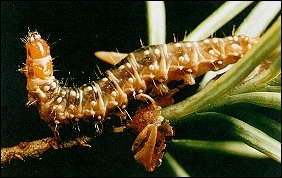
The Western Spruce Budworm (Choristoneura) is the most common and destructive enemy of spruce forests in North America and Canada. The first recorded outbreak of this little worm was in 1909 on the southeastern part of Vancouver Island in British Columbia. Since that time, infestations of this and related species frequently have been reported in western Canada and the United States.
Epidemics
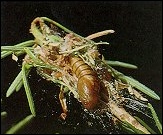
Budworm epidemics seem to have no pattern. They sometimes last a few years, die out naturally, and return. Aerial sprays have been effective in eliminating the worms in some areas. While the exact nature and patterns of life of the Spruce Budworm are documented and well known, exactly how to control or eliminate this little enemy is still somewhat of a mystery.
Life Cycle
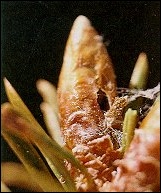
The Budworm has a lifecycle of about 12 months. In late July, adult species will emerge from their pupa as adult moths and will almost immediately will mate. The female deposits her approximate 25 eggs and then dies.
The eggs are oval and light green in colour. They measure 1.2 mm long and have a peculiar overlapping pattern. The female leaves some eggs at the place where she mates and then goes elsewhere. The larvae hatch from the eggs in ten days, but do not feed at this stage. They go under bark and shoots, building silken hibernacula to protect themselves from winter temperatures. Their silken tents are usually visible with inspection, but not easily found. In late June the larvae leave their hibernacula to search for food.
Feeding
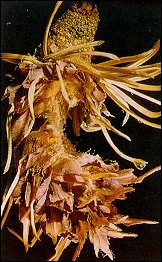
The Budworm larvae like to eat year-old needles and newly developing buds, and leave silken webbing behind them. While the silken tent of the Budworm is impressive, it is not welcome in our forests or on our property. The worms spin lose webs among needles and feed on new foliage. New spruce shoots are often webbed together in twisted and stunted forms. New foliage is destroyed before older needles are consumed. During this period the larvae go through 6 stages of colour.
At the end of this period, the larvae become adult moths with a wing span of 22 to 27 mm. The damage to the spruce shoots begins to turn reddish brown and dry up. After about ten days, the cycle of life repeats itself with mating, eggs, larvae, hibernation, food consumption, and adulthood.
Young host trees (under 4 feet tall), growing under older ones who have provided protection for the silken tents over the winter, are often at great risk from eating larvae who love their tender new shoots. New seedlings often suffer severe damage and delay regeneration of the new forest bed. Older trees have top damage and are often susceptible to other forms of damage when they have encountered the spruce Budworm. The combination may result in the loss of an older tree.
Uninvited Guests
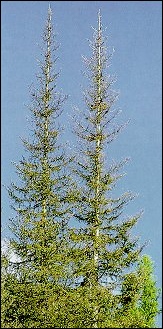
Controlling these losses and preventing the delay of new forest bed growth are the challenges presented by the Budworm. While the larvae seem to have a large number of natural enemies in nature, spruce trees are still extremely vulnerable to Budworm attack. Harsh weather conditions and starvation sometimes help reduce a Budworm population. Chemical insecticides and microbial insecticides are occasionally effective on individual trees and small areas.
With its colour and shape, the Spruce is a beautiful tree. Caledon Treeland has beautiful ones for sale: (905) 880-1828

